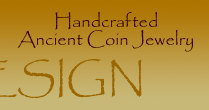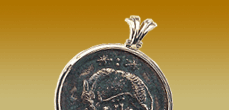







|
History of Ancient Coins
Coinage, as we know it today, originated in Asia Minor approximately 700 years before the birth of Christ. The concept of applying a fixed value to lumps of metal bearing primitive designs, in place of the age-old custom of bartering, quickly spread to nearby centers of Greek civilization. The coinage concept underwent an evolutionary process that paralleled the artistic development of the archaic period of Greek art. By the end of the 5th century B.C., great artistic achievements in design and engraving had been realized. With the arrival of the Hellenistic Age in the middle of the 4th century B.C., further innovations appeared. The practice of dating coinage began (time being reckoned from the beginning of a local era) and, for the first time in history, the true-to-life portraits of historical figures, rather than mythological figures, were used as main coin types. Further advances along the evolutionary path from the crude marking of bits of metal to modern minting were introduced by the Romans, who, by the 1st century B.C. had conquered most of the known world. Among the greatest contributions made by these political innovators were the use of the coins for the dissemination of propaganda and the refinement of the portraiture. Some of the earliest known coins were the gold and silver staters and fractions struck during the reign of King Croesus of Lydia (561-546 B.C.). King Croesus is credited with the introduction of pure silver and gold coinage. These Lydian coins were also the first to be struck according to a specific weight standard capable of being recognized and valued by other Greek city-states and were stamped with an individual and identifiable symbol indicating the coins type and weight standard. The natural Greek sense of individuality and ancestral pride led to strong competition between the city-states, as each sought to produce coins more beautiful than those of their neighbors. Athens, one of the most economically powerful of the city-states, issued coinage which was recognized and accepted in most marketplaces within the range of Greek traders and merchants. Its "owls," as these coins were commonly known, changed very little over three centuries which marked Athens’ dominance, a factor which also strengthened the coins’ acceptability as a standard of currency in a world without international banks or national currencies. While Athens was probably the artistic heart and economic hub of the Greek world, many other Greek settlements around the world developed their own unique coinage. When Alexander the Great unified the Greater Greek World, he strove to unify and standardize the coinage used in his empire. Greek civilization began taking an interest in its contemporary history and at the same time realistic portraiture achieved a higher level of importance. Whether this change of direction and values can be attributed solely to the Hellenistic age or whether it indicates Roman influence is still a matter of academic debate. The Romans’ emphasis on the use of coins in dispensing propaganda was clearly as great as their emphasis on the portrait of the emperor or person who issued the coin. Even though the most significant aspect of a Roman coin is the historical information it possesses, one should not overlook the great care and attention to style used in engraving many of the dies. Some of the portraits of emperors attained such a high degree of accuracy and detail that even the master engravers of the Renaissance or the 18th century failed to attain these artistic heights. During the Roman Empire, coinage attained the numismatic tradition followed by most succeeding western coinage. The quest for better portraiture continued until the time of Caracalla, when more emphasis was placed upon quantity rather than quality. Coin types soon became more limited and less creative, and the portraits of emperors became less accurate. By the time of Constantine the Great, the images carried on most coins were much more stylized representations of the emperors than actual portraits. Christianity was adopted during the reign of this emperor, and its influence is evidenced by a non-temporal flavor of the coinage. Throughout the following centuries, the coins of the ancient Greeks and Romans have set the artistic standard for contemporary engravers. Aesthetically, these coins, having survived the test of time, are held by many to be the finest ever made. Historically, these coins are our most accurate records of ancient civilization and of magnificent generals, kings, emperors, and their pantheon of gods. Without these coins, there would be little understanding of ancient history and even less accurate comprehension of our own western culture. a |